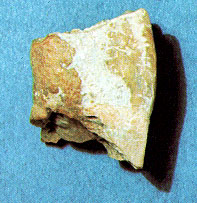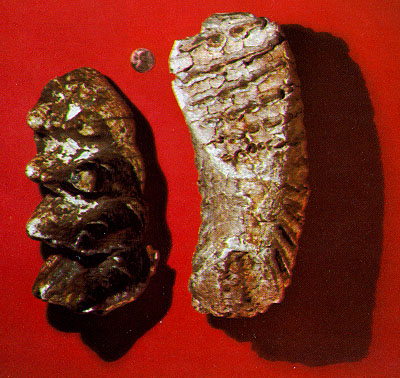



Ancient Life in Kansas Rocks, part 24 of 27
Pliohippus represented a stage in the development of the modern horse from an animal no larger than an average-sized modern dog. Pliohippus was about the size of a pony, and differed from earlier "horses" in having only a single toe. Here, at lower right, is a molar from this extinct horse. (Ogallala Formation, Pliocene)

Two kinds of fossil elephants are commonly found in Kansas, the mastodon and the woolly mammoth. Remains of these extinct animals are commonly found in gravels and bottom lands and other unconsolidated earth. They are easily distinguished from each other by the appearance of their teeth. Mastodon molars at the left have large conical cusps, are low crowned and rooted, whereas the mammoths and other true elephants have molars, right, with 12 to 30 high, thin, transverse enamel ridges or crests, high crowned and rootless. Mammoth teeth acted like mill-stones, with varying hardnesses across the grinding surfaces.

Mastodons were smaller than mammoths, not exceeding a height of 9.5 feet at the shoulder. They ranged over the entire United States and Canada, and became extinct in post-glacial time, possibly even within the span of written history. They were hairy with a heavy undercoat of wool. Since pottery and charcoal, evidence of campsites of early man, have been discovered in levels of earth below, and hence older than those at which mastodon remains have been found, it is probable that mastodons were hinted by men.
Mammoths were the largest North American land mammals to have ever lived, growing to a height exceeding 13.5 feet at the shoulder, and were the only true elephants to have been native to North America. The best known of them ranged along the front of the glaciers and southward as far as Texas and Florida. Some have been found frozen (the flesh still edible) in frozen gravels in Siberia, and it has been determined that they ate grasses in summer and needles and twigs from coniferous trees in winter. Pictures of them have been found on walls in the cave dwellings of Cro-Magnon man in Europe. They are called "woolly" because of their dark brown to black hair that was up to 20 inches long, over a dense layer of wool up to 12 inches thick. (Pleistocene, eastern Kansas)
Kansas Geological Survey
Placed online Feb. 1997
URL = "http://www.kgs.ku.edu/Publications/ancient/f24_mammals.html"
Send comments and/or suggestions to webadmin@kgs.ku.edu